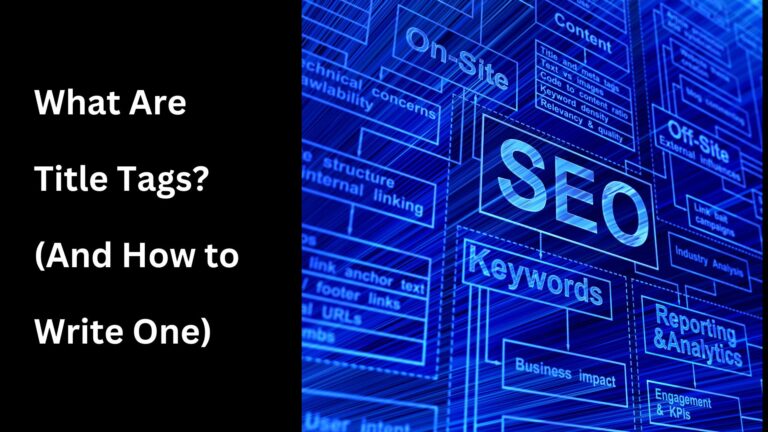|
Getting your Trinity Audio player ready...
|
Last updated on May 12th, 2025 at 10:15 pm
Thank you for reading this post, don't forget to subscribe!You’ve probably encountered a title tag. It’s the first thing you interact with on a Search Engine Results Page (SERP) and will either draw you in or convince you to go to a different article. What are title tags? A title tag is an HTML code that shows the title of a webpage.
Readers encounter title tags as the blue clickable text that takes them to a webpage. It also appears at the top of a browser tab. It’s also what appears when a post is shared on social media.
This seemingly mundane thing can significantly affect your website traffic and Google rankings. Think of it like a book title. It sets the stage for your site to shine.
What Are Title Tags in HTML?
They are written as <title> in HTML and come after the <head> tag. An example of what it looks like in HTML in code is: <title>This is The Title for My Article</title>
More often than not, content management systems (CMSs) will set the title tag automatically once you enter a title.
Image by Pexels from Pixabay
Are Title Tags Important for SEO?
100% they are. It takes a good title tag to attract an audience and improve a website’s Google rankings.
Regarding SEO, title tags come second only to content, and you know content is king. That’s how important they are!
A title tag summarizes your content and lets Google know what the page is about. It tells Google whether your content is relevant. It also carries the keywords you’ve chosen for ranking and offers a perfect opportunity to impact the click-through rate (CTR). Done right, that potentially improves ranking.
Structurally, the title tag sits highest on the hierarchy. It carries more weight than subheadings when giving information about your content.
How Do You Write a Title Tag?
The biggest thing to consider is that you’re writing to appeal to both humans and search engines. You’re aiming for maximum visibility and optimization.
Your title tag could be the same as your H1 or different. Why would there be a difference? For starters, title tags should be more catchy and have a character limit.
H1s are the first heading you see once the webpage loads. There’s room to play around with it and make the H1 more detailed, thus giving your audience a better picture of the article.
1. Watch the length
A lengthy title will likely not display in full on SERPs. You’ll often see an ellipsis where search engines have reached their character limit.
How Long Should Title Tags Be?
Sixty characters are all you have, on average. While you can make the title tag as long as you want, most SERPs will usually display the first 50 to 60 characters. You want your audience to read the full title and get the right picture.
There’s no specific number because the display is based on pixels. Some letters take up more space and will fill up the 600-pixel container faster than others. Keep capital letters to a minimum since they naturally take up more space. They’re also not that nice to look at if you have an ALL CAPS title.
Sometimes search engines will rewrite your titles. We’ll look into why this could happen and how to prevent it a little further in the article.
Image by PublicDomainPictures from Pixabay
2. Every Page Should Have a Unique Title
A unique title tells search engines the content is also unique and valuable. Users are also more likely to click on it.
Avoid default or generic titles such as “Home” or “Product page.” Would you click on them if it were you?
3. Go Easy on Keywords
Keywords are important but don’t stuff them into your title. Variations of the same keyword throughout the title could also get bad results. Search engines are getting smarter! Your readers also won’t like it.
4. Consider Your Audience
You can’t afford to ignore user experience. Your audience needs to find your title attractive and valuable. The title is also their first impression of you before they get to the website. Make every word count.
Why Search Engines Rewrite Title Tags and How To Prevent It
On some occasions, Google may change your title. Why does this happen?
1. Keyword Stuffing
Search engines don’t like it when you try to fit all possible keyword variations in the title. Make your title useful and user-friendly.
2. It Seems Irrelevant
Does the title correspond with the content? Does it match the searcher’s intent? It goes beyond generic titles. Adjust your title for relevance in all aspects.
3. It’s Too Long
You’d expect Google to cut off the title when it’s too long, but they decided that’s not enough. Recently, it began using bits from different parts of the title or adding text from the content. It may be for your site’s good, but it’s unpredictable!
Adjust your title lengths accordingly and watch them remain unchanged. SEO industry standard is about 50 to 60 characters based on what SERPs show.
Image by Alexa from Pixabay
4. An Alternate Title
You may have included a meta tag for Twitter or any other site. Google sometimes picks this alternate title data instead. It may not be disastrous, but if it messes up how your title appears on SERPs, you may want to change it.
How Do I Change a Title Tag?
Generally, this should be easy to do with most CMSs. You can do it on the title tag field under metadata settings or within the code.
Good Title Tag Examples
A good title tag will include a primary and secondary keyword and a brand name if possible or useful. If your brand name already has some good publicity and visibility, take advantage of it.
Primary Keyword – Secondary Keyword | Brand Name
8-inch Beige Heels – Heels | Clarks
You can optimize further by having the primary keyword closer to the beginning of the title. Whatever you consider unique or the selling point for that page should receive prominence in the title.
Having the brand name first may provide minimal value when a user sees it before the product type. If Google truncates the title, the most important bit could easily get lost, and that’s not optimal.
In the spirit of avoiding keyword stuffing, the example below is something to avoid:
Pretty Heels | Affordable Heels | Heels for Sale
Photo by Edho Pratama on Unsplash
Conclusion
A title tag is a significant part of your web pages. Make it easy for your readers to connect with it. SERPs are also watching, so make it count towards your ranking.





